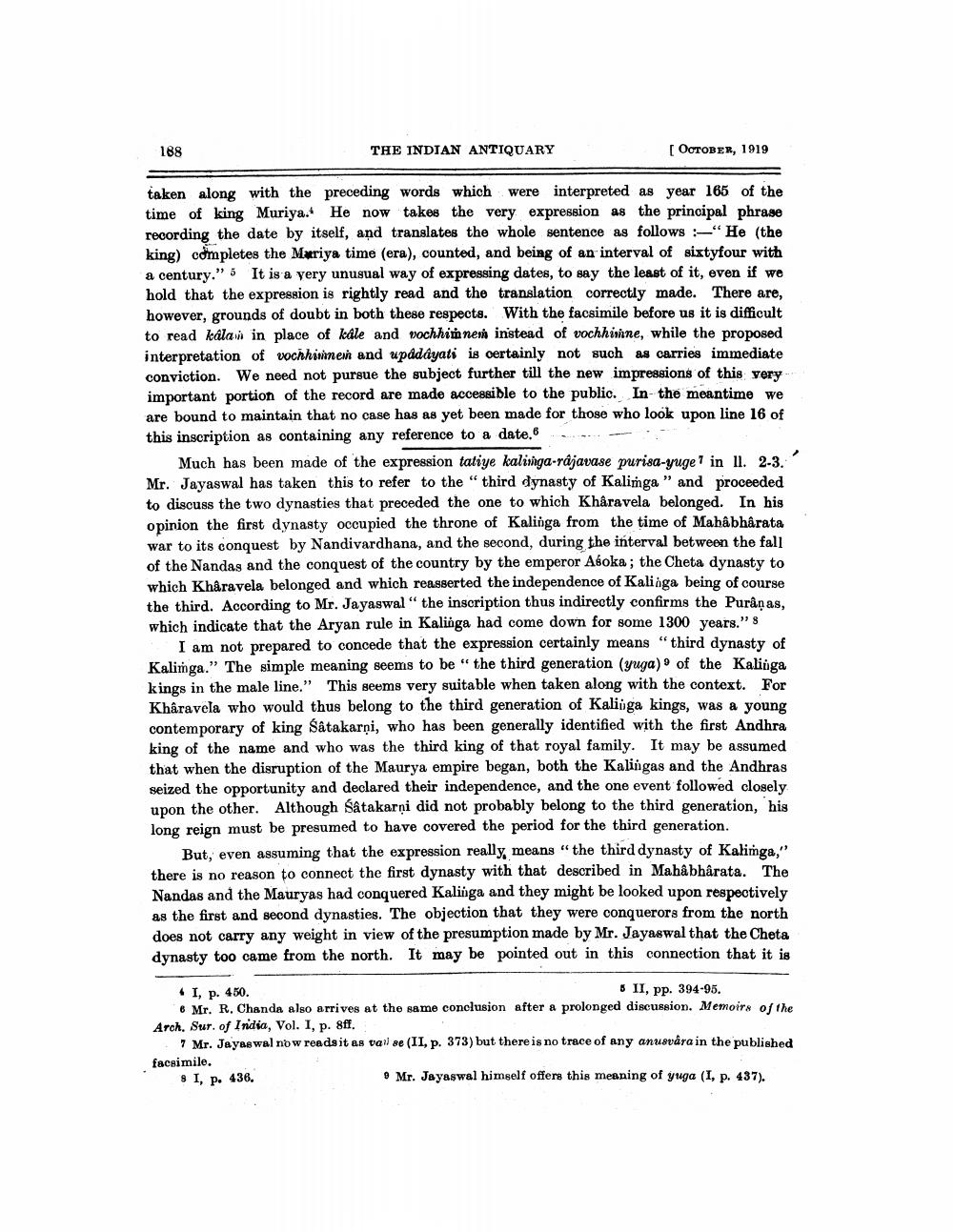________________
188
THE INDIAN ANTIQUARY
[ OCTOBER, 1919
taken along with the preceding words which were interpreted as year 165 of the time of king Muriya. He now takes the very expression as the principal phrase recording the date by itself, and translates the whole sentence as follows:-"He (the king) completes the Mariya time (era), counted, and being of an interval of sixtyfour with a century." It is a very unusual way of expressing dates, to say the least of it, even if we hold that the expression is rightly read and the translation correctly made. There are, however, grounds of doubt in both these respects. With the facsimile before us it is difficult to read kala in place of kále and vochhimnem instead of vochhine, while the proposed interpretation of vochhimmen and upadayati is certainly not such as carries immediate conviction. We need not pursue the subject further till the new impressions of this very important portion of the record are made accessible to the public. In the meantime we are bound to maintain that no case has as yet been made for those who look upon line 16 of this inscription as containing any reference to a date.6
Much has been made of the expression tatiye kalimga-rájavase purisa-yuge in ll. 2-3. Mr. Jayaswal has taken this to refer to the "third dynasty of Kalimga" and proceeded to discuss the two dynasties that preceded the one to which Khâravela belonged. In his opinion the first dynasty occupied the throne of Kalinga from the time of Mahâbhârata war to its conquest by Nandivardhana, and the second, during the interval between the fall of the Nandas and the conquest of the country by the emperor Aśoka; the Cheta dynasty to which Khâravela belonged and which reasserted the independence of Kalinga being of course the third. According to Mr. Jayaswal" the inscription thus indirectly confirms the Puranas, which indicate that the Aryan rule in Kalinga had come down for some 1300 years." s
I am not prepared to concede that the expression certainly means "third dynasty of Kalinga." The simple meaning seems to be "the third generation (yuga) of the Kalinga kings in the male line." This seems very suitable when taken along with the context. For Kharavela who would thus belong to the third generation of Kalinga kings, was a young contemporary of king Satakarni, who has been generally identified with the first Andhra king of the name and who was the third king of that royal family. It may be assumed that when the disruption of the Maurya empire began, both the Kalingas and the Andhras seized the opportunity and declared their independence, and the one event followed closely upon the other. Although Sâtakarni did not probably belong to the third generation, his long reign must be presumed to have covered the period for the third generation.
But, even assuming that the expression really means "the third dynasty of Kalinga," there is no reason to connect the first dynasty with that described in Mahâbhârata. The Nandas and the Mauryas had conquered Kalinga and they might be looked upon respectively as the first and second dynasties. The objection that they were conquerors from the north does not carry any weight in view of the presumption made by Mr. Jayaswal that the Cheta dynasty too came from the north. It may be pointed out in this connection that it is
4 I, p. 450.
5 II, pp. 394-95.
6 Mr. R. Chanda also arrives at the same conclusion after a prolonged discussion. Memoirs of the Arch. Sur. of India, Vol. I, p. 8ff.
7 Mr. Jayaswal now reads it as vai se (II, p. 373) but there is no trace of any anusvåra in the published facsimile.
s I, p. 436.
9 Mr. Jayaswal himself offers this meaning of yuga (I, p. 437).




